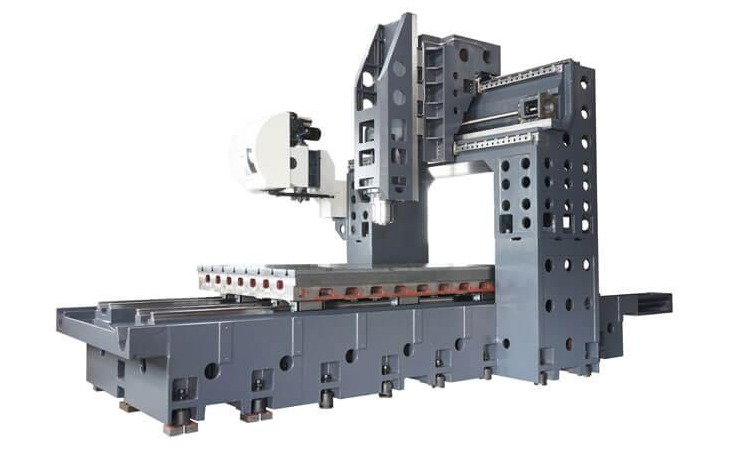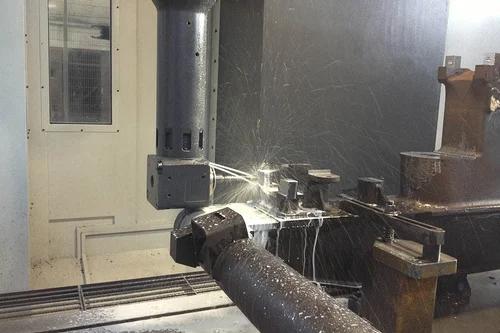In the world of manufacturing and machining, precision and efficiency are paramount. The quest for perfection in creating complex and intricate parts has led to the development of advanced machining technologies.
One such innovation is the Double Column Machining Center. In this article, we will delve into the world of these powerful machines, exploring their features, applications, advantages, and how they contribute to modern manufacturing processes.
A double-column machining center, also known as a gantry machining center, is an advanced machine tool widely utilized in various industries, including aeronautics, aerospace, automotive, and nautical.
These machining centers are prized for their exceptional stability and precision, making them invaluable for producing intricate components and parts used in these industries.
These machines play a pivotal role in the manufacturing of various machines used across different workshops, such as lathes and milling machines, not just limited to automobiles, boats, and airplanes.
In more specific terms, a double-column machining center can perform tasks like machining solid and laminated wood panels and laminated beams. Some operations that can be carried out using these large-scale machine tools include cutting large parts, milling openings (commonly used for crafting doors and windows), and a wide range of drilling and milling operations essential for plumbing and specific electrical work.
In essence, a double-column machining center is a versatile and high-precision machine tool designed to cater to the demands of heavy industries, where complex structures and large parts are the norm. Its ability to provide stability and precise results makes it a vital asset in producing components used in critical applications across various sectors.

A double-column machining center is constructed to achieve exceptional stability and minimize stress and deformation that could negatively impact the machining process. It's worth noting that these machines are characterized by their substantial dimensions, occupying a considerable amount of space within the workshop.
The gantry machining center distinguishes itself from conventional machining centers by orienting the machine's axis perpendicular to the worktable. In most machines, the milling head is mounted on and moves along a portal structure supported by two vertical columns. The milling head's movement primarily occurs along the Y-axis, with the additional capability to move vertically along the Z-axis.
The table gantry of the machining center follows a path along the X-axis, which greatly facilitates the loading and machining of large and heavy workpieces. Another configuration option for this type of machine involves moving the two vertical columns on which the milling head is mounted along the fixed bed or table.
Depending on the specific machine model, this configuration can enable higher-speed movements across all three axes (X, Y, Z), enhancing the machine's capacity to handle heavier workloads.
Double-column machining centers are known for their multi-axis capabilities and additional positioning axes in the milling head and the table. This feature simplifies the machining of workpieces from various angles in a single operation.
Furthermore, these machines have automatic tool changers in the milling head, allowing seamless transitions between different machining tools.
It's important to emphasize that this type of machining center is called "double gantry" due to its two supporting columns or beams. This versatile machine tool can also be configured in a fixed-beam or mobile-beam mode to suit specific machining requirements.

Double-column machining centers are versatile and highly automated machines used to precisely machine large and complex workpieces. They work by:
● Workpiece Fixation: The workpiece is securely clamped onto the worktable, often equipped with features like rotary tables or pallet systems for multi-face machining.
● Tool Selection: The appropriate cutting tool is selected based on the machining operations required, such as milling, drilling, or tapping.
● CNC Programming: Operators input machining instructions into the CNC (Computer Numerical Control) system, specifying tool paths, cutting speeds, and other parameters.
● Tool Movement: The CNC system controls the movement of the cutting tool, which is housed in the cross rail or beam. The tool moves along the X, Y, and Z axes as necessary to perform precise machining operations on the workpiece.
● Material Removal: As the tool moves, it removes material from the workpiece, shaping it according to the programmed design.
● Coolant and Chip Management: Cutting fluid or coolant is often applied to the cutting area to dissipate heat and remove chips and debris generated during machining.
● Quality Control: Sensors and measurement devices may be used to monitor the machining process, ensuring the final product meets desired specifications.
There are several types of double-column machining centers, including:
● Fixed Bridge: The cross rail is fixed in place, and the worktable moves along the X-axis.
● Mobile Bridge: Both the cross rail and worktable can move, offering flexibility in positioning for heavy and large workpieces.
● Gantry Style: Similar to mobile bridge, but with an extended bridge structure for additional stability and support.

Double-column machining centers find diverse applications across various industries due to their robust construction and multi-axis capabilities. Here are some common applications of double-column machining centers:
● Aerospace Industry: These machining centers are used for machining large aircraft components, such as wing spars, fuselage sections, and engine parts. The ability to handle heavy and oversized workpieces makes them ideal for aerospace manufacturing.
● Automotive Industry: Double-column machining centers produce automotive parts like engine blocks, transmission housings, and chassis components. Their precision and versatility are crucial for meeting the stringent quality standards of the automotive sector.
● Die and Mold Manufacturing: Tool and die makers utilize these machines to produce molds, dies, and tooling for various industries, including plastics, rubber, and metalworking. The multi-axis capabilities allow for intricate and precise mold and die machining.
● Energy Sector: In the energy industry, these machining centers produce components for wind turbines, hydroelectric turbines, and nuclear power plant equipment. They can handle large and heavy components critical for energy generation.
● Shipbuilding: Double-column machining centers in shipyards manufacture components like propellers, engine mounts, and bulkheads. Their ability to work on oversized parts is essential in shipbuilding.
● General Engineering: These machines are used in general engineering applications for producing various components, including heavy machinery parts, structural components, and specialty tools. Their versatility and precision make them valuable in this sector.
Using double-column machining centers offers several advantages and disadvantages, depending on the specific requirements of a machining operation. Here are the pros and cons of using double-column machining centers:
● High Precision: They offer excellent stability and accuracy, crucial for intricate and large-scale machining.
● Versatility: Capable of performing various machining operations on various materials.
● Efficiency: Their stability allows for high-speed machining, reducing production time.
● Large Work Envelope: Ideal for handling sizable and heavy workpieces.
● Size: These machines require significant floor space, limiting their suitability for smaller workshops.
● Cost: High initial investment and operational costs.
● Complexity: Requires skilled operators and maintenance personnel.

Choosing the right double-column machining center is crucial for any manufacturing operation. Several factors should be considered to ensure the selected machine meets your needs and requirements. Here are six important factors to consider:
Determine the maximum dimensions and weight of the workpieces you will be machining. Ensure that the machining center you choose can accommodate these requirements comfortably. Consider not only the size of the raw material but also the finished part size, as some operations may involve multiple setups.
Evaluate the machine's accuracy and precision specifications, including its positioning accuracy and repeatability. Ensure that these specifications align with the tight tolerances required for your applications. Pay attention to factors like thermal stability and the machine's ability to maintain accuracy over long machining cycles.
Assess the machine's compatibility with your existing tooling and attachments or the availability of compatible tooling in the market. Consider the number of tool holders and the types of tools that the machine's tool changer can accommodate.
The quality and capability of the CNC control system are critical. Ensure that it supports the programming language you are comfortable with and offers user-friendly software for programming and monitoring. Look for advanced features like toolpath simulation, collision detection, and adaptive machining capabilities.
Investigate the availability of service and support for the machine. This includes the availability of spare parts and the responsiveness of the manufacturer or distributor to maintenance and repair needs. Consider the ease of maintenance tasks such as lubrication and calibration.
Create a comprehensive budget, including the initial purchase and installation costs, training, tooling, and ongoing operational costs. Compare the cost of ownership with the expected returns on investment, considering factors like increased productivity and reduced scrap.
Ensure your facility has sufficient floor space to accommodate the double-column machining center. Consider factors like machine clearance, operator access, and material handling requirements. Be aware that some machine designs may require more space for access and maintenance.
Regular maintenance is essential to maximize the lifespan and efficiency of your Double Column Machining Center. This includes:
● Lubricating moving parts
● Cleaning and inspecting the tool magazine
● Calibrating the machine for accuracy
Double-column machining centers are critical tools for industries requiring precision machining of large and complex components. Their advantages in terms of stability, versatility, and efficiency make them indispensable despite their size and cost, but careful consideration of factors and diligent maintenance are essential for their successful operation.